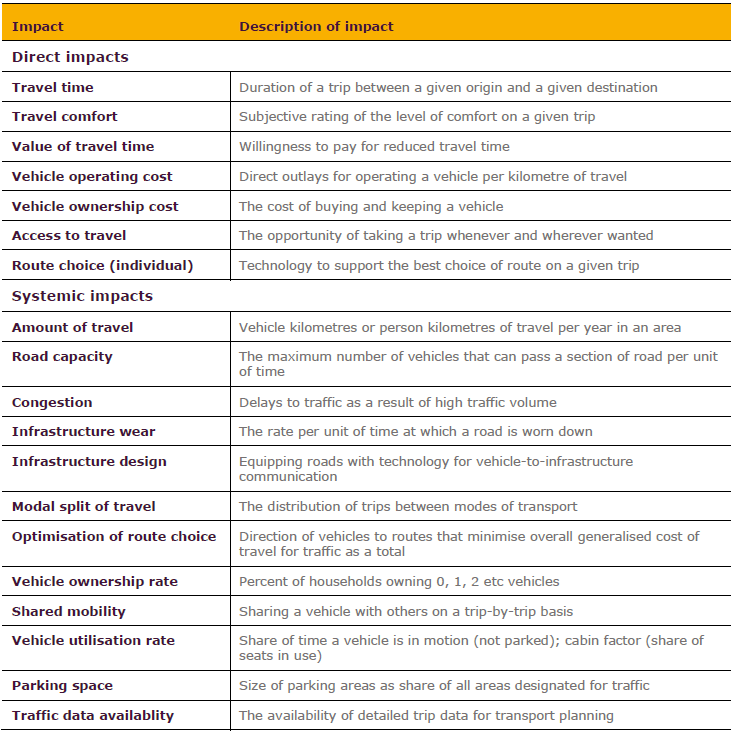This deliverable presents a taxonomy of potential impacts of connected and automated transport systems (CATS) at different levels of implementation. The taxonomy is based on a systematic review of recent studies that have proposed taxonomies of impacts of CATS. There is considerable overlap among the lists of impacts presented by the studies, suggesting a high level of scientific consensus about the potential impacts of CATS.
A distinction is made between direct, systemic and wider impacts. Direct impacts are changes that are noticed by each road user on each trip. Systemic impacts are system-wide impacts within the transport system. Wider impacts are changes occurring outside the transport system, such as changes in land use and employment. Furthermore, a distinction is made between primary impacts and secondary impacts. A primary impact is an intended impact and goes in one direction only; it emanates from the automation technology and has a well-defined outcome. A secondary impact (rebound impact; behavioural adaptation) is generated by a primary impact and feeds back to the source of the primary impact. An example is that reduction of travel time as a result of less congestion tends to induce more traffic, which in turn increases congestion (although not necessarily back to the original level).
Some impacts are nested within each other. For example, lower operating costs, improved travel comfort and reduced travel time all contribute to reducing the generalised costs of travel. In travel demand modelling, the amount of travel is usually modelled as a function of the generalised costs of travel. In this deliverable, potential impacts have been identified at their lowest and most detailed level, although subsequent analyses may aggregate clusters of impacts into more general variables.
As a result of the detailed description of impacts, a large number of potential impacts have been identified. There are 7 direct impacts, 12 systemic impacts and 14 wider impacts; in total 33 impacts. Table S.1 lists these impacts. All impacts are assumed to be generated by automation technology. It is reasonable to expect that the higher the level of implementation of automation technology, the more extensive impacts will become. Implementation is a multidimensional concept. It is therefore envisaged that a broad range of methods must be used in order to adequately describe and quantify as many of the potential impacts as possible. Deliverable D3.2 will review methods for predicting impacts of connected and automated vehicles. One possibility is to think of impacts as dose-response functions, in which the dose is, for example, the market penetration of an automation technology and the response is the size of an effect, e.g. the percentage change in the number of accidents.
Several of the impacts are related to each other, i.e. one impact influences another impact. It is difficult to identify all interrelationships between impacts. However, for primary impacts that have rebound effects (secondary impacts), it is necessary to model the full causal pathway through the intermediate variables that generate rebound effects. Only by doing so will the final net effect be correctly estimated.

 LEVITATE has received funding from the European Union’s Horizon 2020 research and innovation programme under grant agreement No 824361.
LEVITATE has received funding from the European Union’s Horizon 2020 research and innovation programme under grant agreement No 824361.